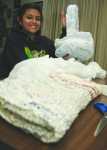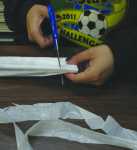Turning trash into treasure

While some people do what they can to recycle everything from aluminum cans to newspaper, a local teen found a way to take what some people might call "trash" and turn it into a unique form of treasure.
Andrea Garcia started to not only reuse what some people would normally throw away but to turn them into something that's functional and gets people's attention.
It started last summer when the Mountain Home Junior High School student turned on her computer looking for creative ideas and projects.

"I like to get on the Internet and just search for things," she said.
Noting that her family had a sizable number of leftover plastic shopping bags in their kitchen, she decided to look up sites to see if anyone had ideas on how to deal with this abundant number of leftovers. One site that caught her eye was titled "knitted plastic bags."
She was immediately hooked.
Over the summer, she used this information to convert her family's pile of used grocery bags into a unique, hand-knitted creation. Her original design was inspired by what she called a hobo stretch bag -- a hand bag that would allow her to carry a large number of items to school. She finished knitting her first creation together just before the new school year started.
"I really liked the texture was and how stretchy it was," she said.
When she showed friends at school her recycled creation, "they were shocked" and amazed how something so simple could become something so unique, the teen said.
This positive feedback prompted Garcia to create a second bag followed by more. Earlier this month, she put the finishing touches on yet another before she began work on a similar hand bag.
"I love watching people's expressions" when they see these bags, she said.
Garcia figures it takes about 70 of these used shopping bags to create just one of these unique handbags. Getting the bags cut down to the needed size is the longest part of the process and can take several days to complete.
To start, she needs to flatten each grocery bag to remove any trapped air. The teen then cuts away the bottoms and handles with these scraps going into a recycling container.
From there, each bag is cut width-wise into one-inch strips, which become what she calls "plarn" -- short for "plastic yarn." These hoops of plastic are then looped together using knitting needles or a crochet hook. A little bit of sewing provides the finishing touches.
Depending on which technique she uses -- and the amount of spare time at her disposal -- it can take up to two weeks to turn out one of these bags. Using a crochet hook actually takes just a couple of days while knitting takes longer, she said.
While people can use small knitting needles or crochet hooks to create things with regular yarn, Garcia's creations need something significantly larger. Normally, she has to use five- or 10-gauge needles and hooks, which range in size from the diameter of an ink pen to the thickness of a person's thumb.
"It's pretty easy to connect them and tie things together," she said.
However, the biggest challenge involves the needles themselves because the plastic tends to stick to them.
"If your hands start to sweat, then everything sticks together," Garcia said.
Once she finished her first handbag, the teen started experimenting with different colors of bags in subsequent creations. It allowed her to create patterns and contrast in these newer bags.
It's pretty much limited to people's imagination, according to Garcia. In fact, others can use similar techniques to fashion artificial flowers and other household items from these reused shopping bags.
"It's not hard to do, and you can do pretty much anything with it," she said.
